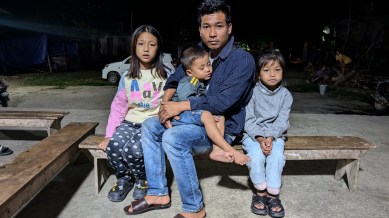A small Manipuri village had escaped the brunt of violence. A surprise attack there has now put the state on edge
On November 7, Zairawn village in Jiribam was attacked, allegedly by members of the armed group Arambai Tenggol. The attack left a Hmar woman, who taught in a local school, dead.

The cycle of violence in Manipur’s Jiribam that started on November 7 has continued for over 10 days, with the latest casualty being 22-year-old Kh Athouba Singh, who was shot dead allegedly during a confrontation between security forces and a large group of protesters in the town Sunday night.
Jiribam had until June escaped the worst of the ethnic violence that had engulfed the rest of the state. But that changed on November 7, following an attack on Zairawn village near the town, allegedly by members of the armed Meitei group Arambai Tenggol. The attack left a Hmar woman, who taught in a local school, dead.
monthly limit of free stories.
with an Express account.
In a span of 11 days since the attack, 21 people have died in the small district.
From multiple accounts of locals and security officials, the attack on the Hmar village of Zairawn, located around eight kilometres from the Jiribam police station, was unexpected, both because it was seen as an unlikely target and because there was no provocation or tension leading up to it.
In fact, many residents of Zairawn, including the woman who was killed and her family, had moved back there in early October, after having fled to Assam in June, in the early days of tensions in Jiribam.
Her husband, Ngurthansang (33), said they and their three children had moved back to Zairawn around a month before the incident after having spent four months in a relief camp in Hmarkhawlien, a Hmar village in the neighbouring Cachar district of Assam.
He is now back in Hmarkhawlien after his home was set on fire. He said they had returned to Zairawn with several other villagers when the school there, where his wife was a teacher, reopened after several months.
“We had all come here (Hmarkhawlien) on June 7 after Kuki and Hmar houses began being burned in Jiribam. We spent several months here, doing daily wage work to support our children. Then, her school reopened and we felt like things were more normal so we decided to go back (to Zairawn). We also had a sense of security because of the peace treaty,” he said.
He was referring to an agreement that Meitei and Hmar groups from Jiribam had arrived at on August 1 after two rounds of talks mediated by the District Collector, Superintendent of Police, the DIG CRPF of Jiribam, and commandants of the 39 Assam Rifles and 87 Battalion CRPF.
Ngurthansang said that when his family travelled back to their village, their vehicle had been stopped and checked by Meiteis at Jiribam and allowed to move forward to their village.
The month before the attack, he said, had been without event.
“I would work on my farm during the day, my wife would teach in her school and our children too were attending school. Things felt safe, but still, many of the people from the village would sleep together in one place and we kept to ourselves,” he said, adding that while villagers like him did not have weapons, there were armed “village volunteers” from elsewhere – mostly from Churachandpur and Pherzwl – present in the village.
While Zairawn had been untouched by conflict, its two nearby Kuki villages of Mongbung Kuki and Sejang – groups representing which had not been part of the talks and agreement – had been having exchanges of fire with the Mongbung Meitei village through September and October.
“The Hmars of Jiribam had shown some interest in talks. It had appeared they even wanted to detach from the conflict. So, why a Hmar village was attacked, without any instigation, is a mystery,” said a security official.
The security official said that before June, Jiribam had a minor presence of Arambai Tenggol, but that the mobilisation around the Mongbung area had grown in the months preceding their attack on Zairawn and the current cycle of violence.